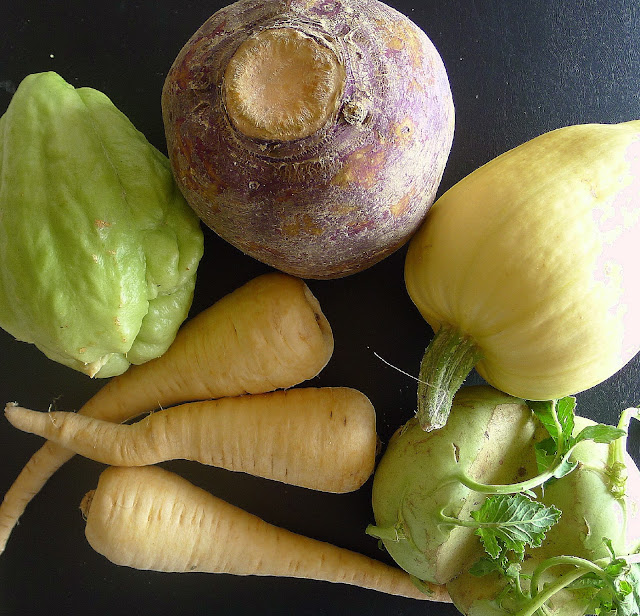From the tascas of Madrid to the tapa bars of Málaga, gambas al ajillo—sizzling, garlicky shrimp—is a favorite tapa (known as gambas al pil pil in Málaga). That’s because it’s a real sensory experience: first you catch a tantalizing whiff of garlic. As the lid is lifted from the little clay dish, the oil spits and splutters. Small pink shrimp, golden slices of garlic and red flecks of chile dance in the oil. Dip chunks of bread into the sizzling juices and fork up the tender shrimp. Wow.
Because it’s a classic, I included Sizzling Garlic Shrimp on the tapas menu for a cooking class I had last week in my kitchen. But, after the meatballs and tortilla, boquerones and orange salad, plus a lot of chatter, we never got to the shrimp. So, the following day, I cooked the shrimp that I had prepped for the class for myself. But I pretty much reinvented the classic.
 |
| A few changes on classic gambas al ajillo (sizzling shrimp)--pieces of chorizo and a slosh of fino Sherry go into the bubbling oil. |
I had already begun the variations on the traditional recipe. For convenience, I bought frozen langostinos*—jumbo shrimp—instead of fresh gambas—small to medium shrimp that are usually used for this dish. And, now that I have an induction cooktop, I can no longer use the little earthenware cazuelitas. So I cooked all of the shrimp in a deep skillet, instead of in individual servings.
Some leftover soft chorizo and an open bottle of fino manzanilla (Sherry from Sanlucar de la Barrameda) inspired more changes. And, because I think green leafy vegetables improve just about anything, I added a handful of chopped spinach.
First I served the shrimp, sort of like the original tapa, with chunks of bread to sop up the savory juices. For another meal, I served the shrimp, chorizo and spinach with all their spicy juices over cooked rice.
 |
| Jumbo shrimp in olive oil with chorizo and bits of hot chile. |
 |
| You'll need chunks of bread to soak up the savory juices. |
 |
| A tapa becomes a meal--the sautéed shrimp with garlic and chorizo plus spinach, served over rice. Fino (dry) manzanilla or Sherry is the perfect wine pairing for the shrimp. |
Sizzling Garlic Shrimp with Sausage and Spinach
Gambas al Ajillo con Chorizo y Espinacas
Gambas al Ajillo con Chorizo y Espinacas
As a tapa, I had portioned four jumbo shrimp per person. So I had 20 peeled shrimp weighing 13 ounces. That made three good-sized servings (main dish with rice) or four smaller servings as a starter. Incidentally, the shrimp for this dish are peeled--including the tails. I used soft cooking chorizo** but sliced, hard-cured chorizo could be used too. And, I bet leafy chard or kale would be as good as spinach in this dish.
½ cup olive oil
4-6 cloves garlic, sliced crosswise
4 slices dried chile or red pepper flakes
2 ounces chorizo sausage, chopped
20 peeled jumbo shrimp (about 14 ounces)
1 cup chopped fresh spinach
¼ cup fino (dry) Sherry
Salt
Chopped parsley
Cooked rice as an accompaniment (optional)
4-6 cloves garlic, sliced crosswise
4 slices dried chile or red pepper flakes
2 ounces chorizo sausage, chopped
20 peeled jumbo shrimp (about 14 ounces)
1 cup chopped fresh spinach
¼ cup fino (dry) Sherry
Salt
Chopped parsley
Cooked rice as an accompaniment (optional)
 |
| Shrimp sauté in minutes. |
Heat the oil on medium-high in a deep frying pan. Add the garlic, chile and chorizo. When the garlic begins to turn pale gold (1-2 minutes), add the shrimp and spinach. Sauté, turning the shrimp, until it turns pink, 2-3 minutes. Add the Sherry and cook until the alcohol is cooked off, 2 minutes. Season with salt.
Serve the shrimp immediately, spooned over hot rice, if desired. Garnish with chopped parsley.
Links to more recipes "al ajillo," with a "little" garlic:
**If you were wondering, what is soft, cooking chorizo?: https://mykitcheninspain.blogspot.com/2012/02/intro-to-chorizo-101.html
*What's the difference between langostino and gamba? shrimp and prawn? https://mykitcheninspain.blogspot.com/2018/01/a-shrimp-by-any-other-name.html































